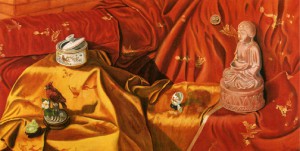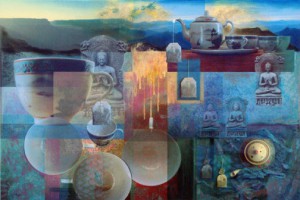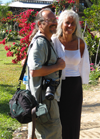Living Life as an Artist
unabridged article written by Julia Courtney, curator of art at the Springfield Museum of Fine Art, Springfield, MA
This is the unabridged version of the article that appeared in The Artist’s Magazine, April 2007 edition, titled Artistic Escape, written by Julia Courtney, Curator of Art at the Springfield Museum of Fine Art, Springfield, MA
Laying face up on the bed, knees bent and my feet resting on the cool, smooth Mexican tile floor, I listen. The sound of children laughing circles through the heavy, humid air. Their voices sing to me through the sheer cotton drapes that blow in the breeze and offer just enough privacy on the balcony. It is Sunday, a day of rest. The children of La Boca de Tomaltan splash each other, climbing in and out of little boats or “pongas” used to cross the mouth of the river. They throw sticks in the water for community dogs to fetch and giggle in amusement as the dogs obediently comply. There are no shiny plastic toys in sight, no shovels, no boogie boards, no ipods with headphones. The fishing boats and their crews are still on Sunday. No nets to untangle, no motors revved to maneuver the shallow mouth of the river, timing the acceleration with the crashing waves to avoid getting stuck in the sand. Families have gathered under pallapas (palm tree constructions), on the beach between the river and shore laughing and talking and feeding themselves and their kids long into the day. No rush to get somewhere else or to be somewhere else, they are fully engaged in the moment. I am impressed by the laughter and the authenticity of the place. What some might consider to be modest resources create the opportunity for engagement with life, with self, and with art.
The cool tile floor beneath my feet was laid by the hands of local contractors. The tile and everything else used to build Casa de los Artistas had to cross the river by boat. The refrigerator and the furniture, including the large dining tables the artists gather around for meals had to cross the river in the same fashion. The same way I had to cross the river when I arrived. “The Casa” was built into the side of a mountain. The river, beach and town square or “zocalo” of this small fishing village lay at its feet. It is hard to believe that a structure, so solid, so a part of the landscape was just a vision a short time ago. It was the vision of Massachusetts’s artist, Robert Masla.
“Dreaming out loud,” is the term Masla uses when referring to Casa de los Artistas. It is a manifestation of his dreams and teaching philosophy, to live life as an artist. He and his wife, Monica, fell in love with La Boca de Tomaltan, a fishing village about 10 miles south of Puerta Vallarta, Mexico, many years ago. It was Masla’s dream to build a home there and create a business that exposed artists to the beauty of the area as well as to give them an opportunity to relax and focus solely on art making. The home is nestled between the jungle mountains and the Pacific Ocean on the Bay of Banderas. Masla’s intent was to provide a safe haven for adventure. To take care of the details of each artist’s needs, creating a feeling of safety, thus giving them the freedom to create and take risks. Masla operates 10-12 workshops a year at “the Casa” featuring numerous guest artists who facilitate workshops along with himself. The tip of the iceberg for this years schedule features such luminaries as; renowned pastel artist Jane Lund (cover article in the October issue of the Pastel Journal), internationally known watercolor/collage artist Peter Kitchell and Time Magazine published artist/illustrator, James Steinberg. The workshop schedule is full of variety focusing on a range of mediums including watercolor painting, acrylic painting, digital photography, drawing, pastels, collage, yoga and art, to name a few. In addition, Masla acts as a gracious host encouraging and accommodating artists in any level of adventure that piques their interested. This might include hiking the coastal cliffs, snorkeling at Los Arcos National Coral Reef, scuba diving, sea kayaking, teaching an art class at a local school, photographing the village, venturing into Puerta Vallarta to explore the art scene, painting en plein aire and other adventures yet to be named. As Masla prepares to celebrate his fiftieth birthday in March 2007, which will include a retrospective exhibition at the R. Michelson Gallery in Northampton, MA, he shared a bit about the path that led him to living his dream.

To read a review of this exhibition, click the above image or see the link to the article at the bottom of the page

Bob and Rich Michelson at the opening of his 30 year retrospective. To see images from the opening exhibition/celebration at the R. Michelson Gallery, click the above image
As a student at the School of the Museum of Fine Arts in Boston, Bob Masla’s dream was to open a gallery in Boston, which he toiled to make a reality while still in school. The school was a powerhouse of diversity, which influenced Masla a great deal. This venture was inspired in response to the limited exhibition opportunities for the kind of art that Masla was producing in the late 1970’s. Masla coined the genre he calls “spiritrealism”, which he defines as a “perennial experience, one that emphasizes the human element, free of religious dogma, that increases our awareness of our connection to the universe.” Spiritrealism, while maintaining a loose connection to religion is focused more on the “universal” human experience. His concept of spiritrealism has evolved over the years from one that was (searching through and ultimately) rejecting of dogma and external influences to a more experiential level of spirituality. The imagery this translated into was two-fold; it was iconographic representing imagery from different religious traditions, as well as abstract. His work continues to represent the rational and intuitive realms of the human experience, where the two co-exist harmoniously. Masla believes it is the nature of the self to participate in the creation and that a higher source manifests itself as creative energy within people. “Hopefully the energy is used to create something of beauty,” he said. He has always grappled with the juxtaposition of form and formlessness. In the late 1980’s both Masla’s parents died and he was diagnosed with glaucoma. “I felt like the external world was out of control. I went through a period of painting in a tight, controlled manner that was more like trompe l’oeil steeped in symbolism. There was something therapeutic in the technical mastery of it all. As I came to terms with my glaucoma and put my energy into raising our kids they taught me about getting out of myself. My art has always transitioned along with my spirit.
- Ahimsa – there can be no happiness without peace, Masla, 1989, oil and alkyd on linen, 18″x36″
- Dealing with Eye Problems, Masla, 1990, oil and alkyd on panel, 14″ x 13″
- The Feather Healers Still Soar, Masla, 1993 – oil, alkyd, acrylic, metallic fillings, roplex and modeling paste on linen diptych, top canvas 20″ x 42″, botom canvas 38″ x 32″
At this time I was also reawakening my connection, nourishment and healing from being in nature. As my awareness moved from my head and intellect, down to my heart and emotions, I began painting more and more landscapes. I am starting to sense another change coming as I have become less concerned with details and more with the power that comes out of the piece (of art).” Some of Masla’s more recent imagery is in the medium of photo-collage, combining painting and digital photography on the canvas. “My work has always been influenced by photography. It seems very natural to combine the two mediums.” The imagery continues to include iconography from both eastern and western traditions in the form of teacups and daily ritual items.
- Looking into the Falls, (plein air at Niagara), Masla, oil and alkyd on linen, 24″ x 36″
- Tea with Bhuddha, Robert Masla, mixed media digital collage painting on canvas, 20″x30″
Masla”s teaching philosophy, which he employs in his workshops and with inner city art students at DeBerry Elementary School through an artist in residency program, A4E, (Art for Everyone) in Springfield, MA (which he developed 4 years ago and has been funded by the Massachusetts Cultural Council), is an illustration of his personal beliefs and the imagery he creates. As children we have a natural ability to explore the world and experience the sheer joy of living. “As we get older the control of authority figures and other outside influences rob us of this nature of the soul,” he said. Masla imparts this story of a young child crawling on the floor who sees some colored sticks and his/her natural reaction is to play with them. “The child notices that the colors rub off and soon decides to rub the colors on the white space of the floor or wall. The child is in joy or the creative flow. An authority figure walks in and the reaction this figure has will influence this child’s creative life. The most progressive response might be to say, “How wonderful! Let me join you.” A second response might be to say, “I am glad you are interested in coloring, but let’s find some paper to do it on.” The third and clearly most damaging response would be to treat the child like he or she has done something wrong. It is important to examine the messages that we convey in our teaching and our approach to life,” said Masla. “Either it is okay to be yourself and use your imagination and creative impulses, or it is not,” he said. “Some of these responses are actually dangerous; they become weights that we carry around with us that become the voices of our inner critic. Many children can’t draw naturalistically at the appropriate age because they have given up. The stifling of creativity is in reality the stifling of the self.” Masla feels that the arts can teach ethics and moral values, not by force but by providing an opportunity for children to develop into holistic beings that are naturally responsible for their actions. “The arts teach accountability by touching the soul,” he said.
The three artists that have influenced Masla’s approach to life and art include Alton Tobey, who “woke my eyes up to painting, I knew when I was working in his studio at a young age, that I would grow up to be a painter. He influenced both my painting and my teaching style. He showed me that teaching was about drawing the creative influence out of someone, not pushing it on them, to act as facilitator really, not teacher. To have the knowledge and technical ability available but to wait and let them seek it out, not hurry to fill someone else up with what you know.” Tobey died two years ago at the age of 90. When he began studying with Tobey, Masla was the youngest student working in his studio. Second, Masla was influenced by Casper David Friedrich, who was an 18th century painter, considered the father of German Romanticism. “In his somber landscapes he was able to convey infinity and intertwine the spiritual in the landscape, transcending the religious dogma of the time.” In Robert Rosenblum’s book, Modern Painting and the Northern Romantic Tradition: Friedrich to Rothko (1975), the similarities of the two artists can be seen. If you remove the lone monk in the Friedrich landscape, “Monk by the Sea” you have a Rothko painting,” said Masla. Finally, artist Alex Gray influenced him more in terms of his approach to life than stylistically. He was a student at the School of the Museum of Fine Arts in Boston when Masla was there. “I didn’t know him at the time, only that he was working on his polarity project and had long hair on one side of his head and the other side of his head was shaved.” After feeling like a lone voice in the wilderness, Masla realized that Gray and he shared a similar philosophy. Masla cites a book that his father gave him when he was 14 as influential in his choice of subject matter. “This book, called Yoga for You, set the wheels in motion and led me to dive deep into spirituality.” Years later his father confessed that he hoped the book would lead him away from spirituality because it was so “kooky,” when in fact it had the opposite affect. Finally, Masla credits his wife, Monica who taught him about bringing things back to his heart. “Spirituality is a wonderful thing, but she taught me that unless you bring it back to your heart, your life, and your relationships, it is useless. We sacrifice human beings in the name of religion or religious dogma instead of living the highest truth, which is love,” said Masla.
he Casa de Los Artistas is the full embodiment of Masla’s art career. The walls are embellished with his murals, paintings and photographs. His life philosophy can be felt in the warmth of the decor and the aura that awaits the artist in search of adventure. The presence of Masla’s family, wife Monica and children Aiyana (18), Narieka (14) and Brahm (9) can be seen and felt as well. “It is a place where artists can come and get in touch with the intuitive part of themselves. Where the technical instruction is of the highest caliber and the diversity is apparent. I want everyone who comes here to leave with the idea that they got to jump into the unknown, take a course that pushed the envelope for them and stretched their boundaries a bit.”
I found that the warmth, spirit of adventure and the camaraderie at “the Casa” was unsurpassed. My journey to Mexico deeply affected my creative and professional life. When I returned to my studio I brought with me new inspiration, warm breezes, the laughter of children and the freedom to play. It brought a sense of perspective to my work as Curator for the Springfield Art Museums in Massachusetts of the world being a much smaller place than it feels like sometimes. Many of the objects and paintings that I handle and write about daily (some from the far corners of the world) were created in community, this kind of experience has become rare. The Casa provided a creative community in which to work and live, if only for a short time. I know I will return periodically to rekindle the creative flame. By opening this special home to artists, Masla has chosen to share the fruits of living life as an artist with the world.
Masla exhibits his work at Galleria Omar Alonso Contemporary Art And Photography and Gallerie Des Artistes in Puerta Vallarta, Mexico and at R. Michellson Galleries, Northampton, MA and Mallon Fine Art in Indianapolis, Indiana. He conducts workshops in Mexico and at his home studio in Ashfield, Massachusetts. More information about workshops at the Casa de los Artistas or about Bob Masla s art can be seen at www.CasaDeLosArtistas.com or www.ArtWorkshopVacations.com or www.MaslaFineArt.com





































